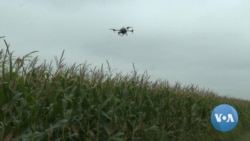ສຳລັບຊາວກະສິກອນ ໃນພາກຕາເວັນຕົກສຽງຕອນກາງຂອງສະຫະ ລັດແລ້ວ, ເທັກໂນໂລຈີທີ່ຄວບຄຸມຕົນເອງຢ່າງອັດຕະໂນມັດທີ່ກໍາລັງພົ້ນເດັ່ນຂຶ້ນ ແມ່ນສາມາດຫຼຸດຜ່ອນຕົ້ນທຶນ ແລະເພີ່ມປະສິດທິພາບໃນຕ່ອງໂສ້ການສະໜອງ ດ້ານກະສິກຳໄດ້. ໃນລາຍການ LogOn ມື້ນີ້, ເຄນ ຟາຣາບັຟ (Kane Farabaugh) ສະແດງໃຫ້ເຫັນຜົນປະໂຫຍດທີ່ອາດນໍາມາໂດຍເທັກໂນ ໂລຈີ ທີ່ໃຊ້ຢູ່ໃນຟາມ ຊຶ່ງບົວສະຫວັນຈະນໍາມາສະເໜີທ່ານໃນອັນດັບຕໍ່ໄປ.
ອະນາຄົດຂອງການປູກຝັງ ແມ່ນຢູ່ທີ່ປາຍນິ້ວ ຂອງທ່ານເດັນນິສ ບາວແມນ (Dennis Bowman). ດ້ວຍການໃຊ້ເຄື່ອງຄວບຄຸມທາງໄກ, ທ່ານໄດ້ທົດສອບເທັກໂນໂລຈີໃໝ່ ກັບສູນກາງກະສິກໍາທາງດີຈິຕອລທີ່ມະຫາວິທະຍາໄລລັດອີລີນອຍ. ເຮືອບິນບໍ່ມີຄົນຂັບ ຫລືໂດຣນ ທີ່ເປັນເຄື່ອງຫວ່ານຝຸ່ນ ແລະ ຫຸ່ນຍົນຫວ່ານແກ່ນພືດ ທາງອາກາດແບບອັດຕະໂນມັດ ເປັນພຽງເຄື່ອງມືສອງຢ່າງເທົ່ານັ້ນ ໃນຄັງສັບພະວຸດທາງກະສິກໍາ ທີ່ທ່ານສາທິດໃຫ້ຊາວກະສິກອນເບິ່ງເປັນປະຈຳ.
ການຊັກຊວນໃຫ້ຊາວກະສິກອນໃຊ້ພວກມັນ ແມ່ນເປັນເລື້ອງນຶ່ງອີກຕ່າງຫາກ.
ທ່ານບາວແມນ, ຜູ້ຊ່ຽວຊານຈາກມະຫາວິທະຍາໄລລັດອີລີນອຍກ່າວວ່າ:
"ມັນມີຄວາມເປັນຫ່ວງກ່ຽວກັບເທັກໂນໂລຈີ. // ແລະມີຄວາມໜ້າສົນໃຈຫຼາຍ ຖ້າທ່ານສາມາດສະແດງໃຫ້ເຫັນວ່າ ມັນຕອບສະໜອງຄວາມຕ້ອງການໄດ້.”
ສໍາລັບທ່ານໄບຣອັນ ຄໍໂຄລ (Brian Corkill) ທີ່ເປັນຊາວສວນ ທີ່ດໍາເນີນວຽກງານປູກຝັງຂອງລາວ ບໍ່ວ່າຈະດ້ວຍຕົນເອງ ຫຼືດ້ວຍແຮງງານທີ່ສ່ວນໃຫຍ່ມາຈາກຄອບຄົວຂອງລາວເອງແລ້ວ ແມ່ນມີຄວາມຕ້ອງການຢ່າງຈະແຈ້ງເລີຍ.
ທ່ານຄໍໂຄລ ຊາວສວນຢູ່ລັດອີລີນອຍເວົ້າວ່າ:
"ນັ້ນຈະເປັນຊັບສິນອັນໃຫຍ່ຫຼວງ ຕໍ່ການດໍາເນີນວຽກທີ່ຂາດແຮງງານຢູ່."
ການທີ່ສາມາດໃຊ້ໂດຣນເພື່ອຫວ່ານຝຸ່ນໃສ່ພືດຂອງຕົນ, ຫຼືລົດຫຸ່ນຍົນອັດຕະໂນ ມັດເພື່ອຫວ່ານເມັດພືດໃຫ້ປົກຄຸມໄປທົ່ວ - ໃນກໍລະນີນີ້ເຂົ້າໄຣ (rye) ຫວ່ານ ໃສ່ ລະຫວ່າງກາງຂອງແຖວສາລີ, ສາມາດຕັດເວລາທີ່ລາວໃຊ້ໃນການປະຕິບັດວຽກງານເຫຼົ່ານີ້ດ້ວຍຕົວເອງລົງໄດ້.
ເຖິງແມ່ນມີທ່າທາງວ່າຈະໃຫ້ປະໂຫຍດສູງກໍຕາມ ແຕ່ທ່ານຄໍໂຄລ ກໍບໍ່ໄດ້ໃຊ້ເທັກໂນໂລຈີທີ່ວ່ານີ້.
ທ່ານກ່າວວ່າ:
“ບາງສ່ວນຂອງມັນແມ່ນຍ້ອນຄ່າໃຊ້ຈ່າຍ. // ເຖິງແມ່ນວ່າມັນຈະຄວບຄຸມຕົນ ເອງແບບອັດຕະໂນມັດກໍຕາມ, ເຈົ້າກໍຍັງຕ້ອງມີຄົນທີ່ຄອຍຕິດຕາມກວດກາມັນຢູ່.”
ແຕ່ວ່າທ່ານບາວແມນ (Bowman) ກໍເວົ້າວ່າການລວມເອົາເທັກໂນໂລຈີ ທີ່ຄວບຄຸມຕົນເອງຢ່າງອັດຕະໂນມັດ ເຂົ້າໃສ່ກັບປັນຍາປະດິດ ຫລື AI ທີ່ພົ້ນ ເດັ່ນຂຶ້ນ ອາດຈະເປັນກຸນແຈນໍາໄປສູ່ການເອົາຊະນະຊາວກະສິກອນເຊັ່ນທ່ານ ຄໍໂຄລໄດ້.
ທ່ານກ່າວດັ່ງນີ້:
"ນຶ່ງໃນສິ່ງທີ່ AI ອາດຈະສາມາດເຮັດໄດ້ ແມ່ນລະບົບທີ່ສະຫລາດກວ່າ ທີ່ສາ ມາດຊ່ວຍວິເຄາະຂໍ້ມູນນີ້ ເພື່ອໃຫ້ພວກເຮົາສາມາດຕັດສິນໃຈໄດ້ດີກວ່າເກົ່າ."
ການຕັດສິນໃຈ, ທ່ານບາວແມນ (Bowman) ເວົ້າວ່າ ບໍ່ພຽງແຕ່ຊ່ວຍຊາວກະ ສິກອນເທົ່ານັ້ນ ແຕ່ຍັງເປັນລະບົບຕ່ອງໂສ້ການສະໜອງດ້ານກະສິກຳ ໃນທົ່ວໂລກອີກດ້ວຍ.
ທ່ານບາວແມນຈາກມະຫາວິທະຍາໄລລັດອີລີນອຍ ກ່າວມ້ວນທ້າຍວ່າ:
"ຂະນະທີ່ພວກເຮົາພະຍາຍາມທີ່ຈະສະໜອງອາຫານໃຫ້ແກ່ໂລກຫຼາຍຂຶ້ນ ແລະຂະນະທີ່ປະຊາກອນເພີ້ມຂຶ້ນ ແລະຈໍານວນເຮັກຕາຂອງພື້ນທີ່ເຮັດກະສິກໍາເພີ່ມຂຶ້ນ, ພວກເຮົາຈໍາເປັນຕ້ອງເພີ່ມການຜະລິດຂອງພວກເຮົາ ແລະປະສິດທິພາບຂອງພວກເຮົາ."
ຕະຫຼາດອຸປະກອນການກະສິກໍາແບບອັດຕະໂນມັດຂອງໂລກໃນປັດຈຸບັນ ແມ່ນມີຫຼາຍກວ່າ 100 ຕື້ໂດລາ ແລະກໍາລັງເຕີບໂຕຂຶ້ນ, ໂດຍທີ່ສະຫະລັດ ແມ່ນ ກວມເອົາປະມານ 30 ເປີເຊັນຂອງຄວາມຕ້ອງການດັ່ງກ່າວ… ຊຶ່ງຄາດວ່າ ຈະເຕີບໂຕຢ່າງຫຼວງຫຼາຍໃນຫ້າປີຂ້າງຫນ້ານີ້ຍ້ອນວ່າຊາວກະສິກອນນໍາໃຊ້ ເທັກໂນໂລຈີຫຼາຍຂຶ້ນ.
ອ່ານລາຍງານນີ້ເປັນພາສາອັງກິດຂ້າງລຸ່ມນີ້:
For farmers in the Midwest United States, emerging autonomous technology could reduce costs and increase efficiency in the agricultural supply chain. Kane Farabaugh shows the promise of the technology on the farm in this edition of LogOn.
The future of farming is available at Dennis Bowman’s fingertips.
Using remote controls, he tests new technology with the Center for Digital Agriculture at the University of Illinois. An arial drone fertilizer sprayer and automated robotic seeder are just two of the tools in the agricultural arsenal he regularly demonstrates to farmers.
Convincing farmers to use them is another matter.
Dennis Bowman, University of Illinois Extension Specialist:
“There’s concern about the technology. // And there’s a lot of interest if you can show that it satisfies a need.”
For Illinois Farmer Brian Corkill, who operates his farm either by himself or with labor that mostly comes from his own family, the need is clear.
Brian Corkill, Farmer:
“That would be a huge asset to an operation that’s labor short.”
Being able to use a drone to spray fertilizer over his crops, or an automated robotic vehicle to spread cover crop seeds – in this case cereal rye – between his rows of corn, can cut down on the time he spends performing these tasks himself.
Yet despite the promise, Corkill hasn’t adopted the technology.
Brian Corkill, Farmer:
“Some of it is the cost. // Even though it’s autonomous, you still have to have someone who is monitoring it.”
But Bowman says integrating the autonomous technology with emerging artificial intelligence could be the key to winning over farmers like Corkill.
Dennis Bowman, University of Illinois Extension Specialist:
“One of the promises of AI is smarter systems that can help analyze this data so we can make better decisions.”
Decisions that Bowman says not only help farmers, but also the global agricultural supply chain.
Dennis Bowman, University of Illinois Extension Specialist:
“As we’re trying to feed more of the world and as the population grows and the number of acres of farmland grow, we need to increase our production and our efficiency.”
The global autonomous farming equipment market currently exceeds $100 billion and is growing, with the United States accounting for about 30 percent of that demand… which is expected to grow dramatically in the next five years as more farmers adopt the technology.





